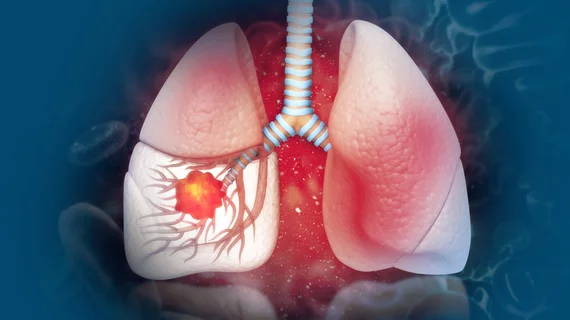Treating pure ground glass nodules is not a cost-effective strategy for imaging practices, according to a new large-scale analysis published Tuesday in Radiology.
Members of the specialty are increasingly identifying such lesions on chest CT, including in about 9% of patients undergoing lung cancer screening. Subsolid nodules have a high risk of becoming malignant, but they also grow slowly and have low potential of metastasizing, noted lead author Mark Hammer, MD.
“This may almost seem like a contradiction, but it presents a problem: How should we choose when to treat these (potential) cancers,” Hammer, a thoracic radiologist at Brigham and Women’s Hospital and assistant professor at Harvard, told Radiology Business by email. “If we address all of the cancers, we will probably end up overtreating a lot of patients who would have died with rather than of these cancers. So, we wanted to see if we can understand when to treat these lesions.”
To find the right balance, Hammer and colleagues used a simulation model, incorporating 10 million current and former smokers (assumed to have ground glass nodules) who underwent CT screening. The nodules were allowed to grow and develop solid components over time, and the model explored management strategies using various treatment thresholds. They further used formulas to determine how much extra the healthcare system might pay to give a patient an extra (quality-adjusted) life-year. In most studies, Hammer noted, people regard $100,000 as the upper limit, which is what the provider is paying, not the patient.
Treatment of pure ground glass nodules based on the Brock risk calculator was not cost effective, failing to yield a beneficial improvement in life-years saved for the investment. However, once a GGN grows a solid component that measures 4 millimeters, it should be treated—a strategy that cost an extra $53,000 per quality-adjusted life year, compared to the next most effective strategy (which had a threshold of 8 mm).
Hammer and colleagues’ findings affirm guidance spelled out in the American College of Radiology’s Lung CT Screening Reporting & Data System, which uses a conservative strategy for nodule management.
“Our study adds weight to those who argue (like the ACR’s Lung-RADS) that pure GGNs should not be treated. Of course, prospective randomized trials would be needed to confirm these findings,” Hammer said by email.
For imaging practices, the key takeaway is how “critical” radiology is to the assessment, follow-up, and eventual treatment of these nodules. Future research could potentially identify the optimal way to treat patients who have part-solid nodules on their initial CT scans, the author added.
You can read more about their results in the Radiological Society of North America’s flagship journal here.

